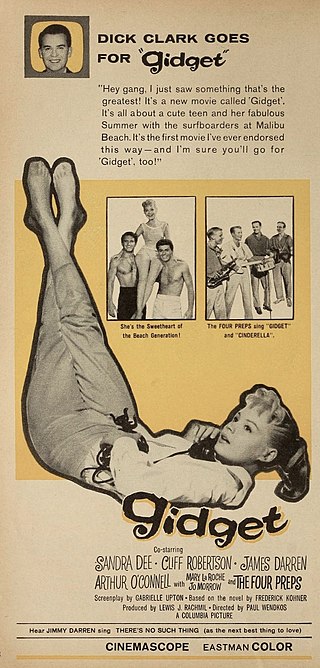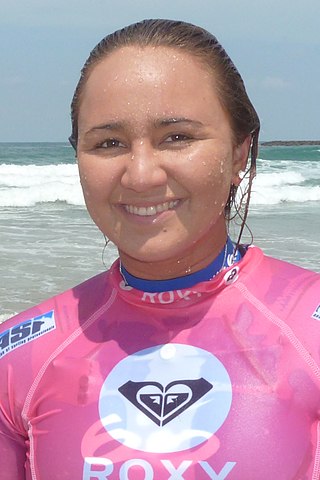| Sport | Surfing |
|---|---|
| Country | United States |
| Most recent champion(s) | |
The Hawaiian Pro is a surfing event held annually at Haleiwa, on the North Shore of Oahu, Hawaii. It is currently the first leg of the Triple Crown of Surfing.
| Sport | Surfing |
|---|---|
| Country | United States |
| Most recent champion(s) | |
The Hawaiian Pro is a surfing event held annually at Haleiwa, on the North Shore of Oahu, Hawaii. It is currently the first leg of the Triple Crown of Surfing.

Duke Paoa Kahinu Mokoe Hulikohola Kahanamoku was a Hawaiian competition swimmer who popularized the sport of surfing. A Native Hawaiian, he was born to a minor noble family less than three years before the overthrow of the Hawaiian Kingdom. He lived to see the territory's admission as a state, and became a United States citizen. He was a five-time Olympic medalist in swimming, winning medals in 1912, 1920 and 1924.

Surfing is a surface water sport in which an individual, a surfer, uses a board to ride on the forward section, or face, of a moving wave of water, which usually carries the surfer towards the shore. Waves suitable for surfing are primarily found on ocean shores, but can also be found in standing waves in the open ocean, in lakes, in rivers in the form of a tidal bore, or in wave pools.

Waikiki is a Honolulu neighborhood and its eponymous beach on the south shore of the island of Oʻahu in the U.S. state of Hawaii.

Robert Kelly Slater is an American professional surfer, best known for being crowned World Surf League champion a record 11 times. Slater is widely regarded as the greatest professional surfer of all time, and holds 56 Championship Tour victories. Slater is also the oldest surfer still active on the World Surf League, winning his 8th Billabong Pipeline Masters title at age 49.

Maro Reef is a largely submerged coral atoll located in the Northwestern Hawaiian Islands. It was discovered in 1820 by Captain Joseph Allen of the ship Maro, after whose ship the reef was named. With a total area of 747 square miles (1,935 km2), it is the largest coral reef in the Northwestern Hawaiian Islands. It contains 37 species of stony coral. Unlike most atolls, the coral extends out from the center like spokes on a wheel. Located about 850 miles northwest of Honolulu, Hawaii, Maro Reef contains about 1 acre (4,000 m2) of dry land which itself can be submerged depending on the tides. Some scientists believe that it "may be on the verge of drowning" because the reefs are detached and are vulnerable to strong storm waves.

Big wave surfing is a discipline within surfing in which experienced surfers paddle into, or are towed into, waves which are at least 20 feet high, on surf boards known as "guns" or towboards. Sizes of the board needed to successfully surf these waves vary by the size of the wave as well as the technique the surfer uses to reach the wave. A larger, longer board allows a rider to paddle fast enough to catch the wave and has the advantage of being more stable, but it also limits maneuverability and surfing speed.

Surf movies fall into three distinct genres:

Surf culture includes the people, language, fashion, and lifestyle surrounding the sport of surfing. The history of surfing began with the ancient Polynesians. That initial culture directly influenced modern surfing, which began to flourish and evolve in the early 20th century, with its popularity peaking during the 1950s and 1960s. It has affected music, fashion, literature, film, art, and youth jargon in popular culture. The number of surfers throughout the world continues to increase as the culture spreads.

Peʻahi is a place on the north shore of the island of Maui in the U.S. state of Hawaii. It has lent its name to a big wave surfing break, also known as Jaws.

Hawaiian scale is an expression of the height of a wind wave affecting water. It is the expression conventionally used by surfers in Hawaii and is also used in Australia and parts of South Africa.
The O'Neill World Cup of Surfing is a prestigious event in professional surfing held annually at Pūpūkea on Oahu in Hawaii.
The Duke Kahanamoku Invitational Surfing Championship is named in honor of the "Father of Modern Surfing", Duke Paoa Kahinu Mokoe Hulikohola Kahanamoku. The contest began in 1965 by invitation only at Sunset Beach on the North Shore of Oʻahu until it was replaced by the Billabong Pro in 1985. The championship was the first surfing event to be broadcast on a regular basis by ABC's Wide World of Sports.

Tube riding is a term used by surfers to describe riding well inside the curve or barrel of a finely-shaped breaking wave. Under the right conditions, waves in some areas, such as the Banzai Pipeline in Hawaii, form a moving "tube" or cylinder as they break.
Derek Ho was a Hawaiian Chinese surfer who won the world surfing championship in 1993. Ho was born in Kailua, Honolulu County, Hawaii. He began surfing at the age of three, and won the world title at age 29, making him the first Native Hawaiian world champion. Derek Ho was the brother of Michael Ho, another champion surfer, and the first cousin of Don Ho, the Hawaiian singer. He was the uncle of professional surfers Mason Ho and Coco Ho.

Paige Frances Hareb is a professional surfer from Ōakura Beach, New Zealand. In December 2008 she became the first New Zealand woman to qualify for the ASP Women's World Tour.

Carissa Kainani Moore is a Hawaiian American Olympian, world champion surfer and activist. She was the first-ever winner of the Olympic Gold Medal in women's short board surfing in 2020. She was also the 2011, 2013, 2015, 2019 and 2021 World Surf League WSL Women's World Tour Champion. Moore is the first surfer in history to win a WSL world title and the Olympic title in the same year.

Surfing in the United States is a popular hobby in coastal areas, and more recently due to the invention of wave pools, inland regions of the country. It contributes to a lifestyle and culture in which millions participate and which millions more have an interest. USA surfing is the governing body for the sport of surfing in the United States, with surf leagues such as the World Surf League available in the country. Surfing can be traced back to 17th Century Hawaii and has evolved over time into the professional sport it is today, with surfing being included for the first time in the 2020 Summer Olympics in Tokyo.

Courtney Conlogue is an American professional surfer. She was born in Santa Ana, California. Courtney learned to surf at the age of 4. In 2004 when she was 11, Conlogue was the youngest athlete to be selected to the USA Junior Surf Team. She went on to achieve 11th place in the 2005 ISA World Junior Surfing Championships. By the time she was 14, she had won a surfing gold medal as a member of the U.S. Team in the X Games. When she was 17 she won the biggest competition in the US at the Hurley U.S. Open of Surfing, held at her home break in Huntington Beach, California.
Keanu Asing is a Hawaiian surfer who competes in the World Surf League and debuted on the World Championship Tour of the 2015 World Surf League.

Women's surfing is thought to date back to the 17th century. One of the earliest records of women surfing is of princess Keleanohoana’api’api, also known as Kalea or the Maui Surf Riding Princess. It is rumored that Kalea was the trailblazer of surfing and could surf better than both men and women. A few centuries later in the mid-late 1800s, Thrum’s Hawaiian Annual reported that women in ancient Hawaii surfed in equal numbers and frequently better than men. Over the last 50 years, women's surfing has grown in popularity.